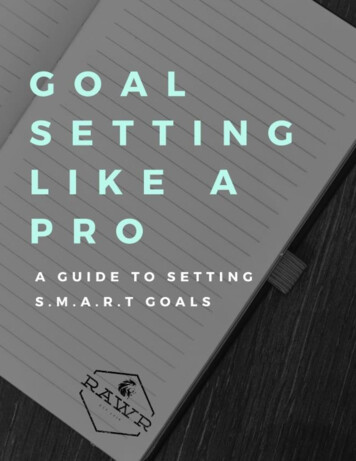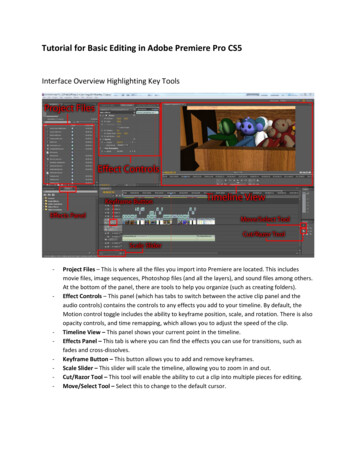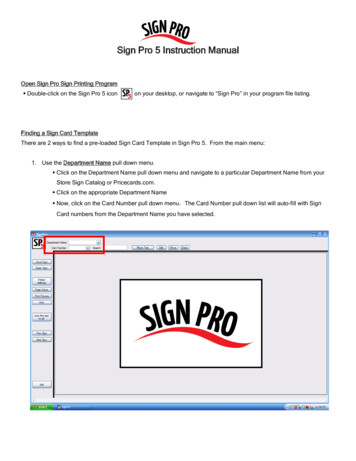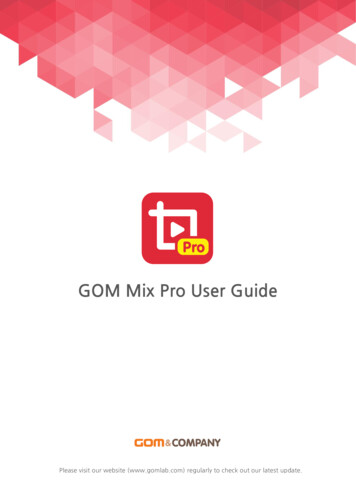
Transcription
GOAL SETTING LIKE A PRO: A GUIDETO SETTING S.M.A.R.T GOALS
Published by RAWR Learningwww.rawrlearning.comCopyright 2019 RAWR LearningAll rights reserved. Neither this book, nor any parts within it may be sold orreproduced in any form without permission.Important Copyright and Legal NoticeYou do NOT have permission to copy, redistribute, resell, auction orotherwise give away copies of Goal Setting Like a Pro: A Guide to SettingS.M.A.R.T Goals, whether in eBook or physical book format. Any yes,eBooks are also protected by international copyright laws.If you attempt to do any of the above methods of distributing this eBook orbook, you are in violation of international copyright laws and are subject tofines and imprisonment. Copyright infringement is a serious crime withfines starting at 150,000 and up, including potential imprisonment uponconviction.Copyright 2019 RAWR Learning. All rights reserved
About RAWR LearningRAWR is about spreading knowledge and life skills to others. There arefour areas of expertise and focus of RAWR:1.2.3.4.Leadership DevelopmentSelf-SatisfactionMaximizing Performance CapabilitiesBetter TrainingLeadership DevelopmentLeadership is an extremely popular topic among books, TED talks,presentations, podcasts, and all other forms of media. Our approach is vastand encompassing because that is what it takes to effectively lead people.We can work with leaders on their self-development as leaders but alsobroadly in culture and organizational development. The key is working withleaders to develop strategies, not merely telling someone how we thinkthings ought to be. Telling someone how to lead is not effective, workingwith them to discover who they are as a leader is how a difference can bemade.Self-SatisfactionWe as humans seek to be satisfied with our lives. This is attained by firstbecoming self-aware of our thoughts, emotions, and physical reactions. Wewill work with others to increase their self-awareness and to put energy andeffort into only the areas they can control. Another aspect is working todevelop effective communication strategies for connecting with people in allaspects of life.Maximizing Performance CapabilitiesRealizing our potential can be a constant challenge as we move throughlife. There are times where we get in our own way, preventing us frombeing as good as we are capable of being. There are skills the best of anyfield utilize and have been researched. We will teach these skills to helppeople be the best they can in their given field.Copyright 2019 RAWR Learning. All rights reserved
Better TrainingTraining takes place to improve and experience growth. Too often due toany of numerous factors, we are not able to give our best to our training.We will to help people be more efficient with their training, maximizinggrowth potential.Purpose of this BookThe purpose of this eBook is to act as an educational tool to help you withyour personal development. This eBook specifically will cover goal setting.The four areas that this eBook will cover are:1. Understanding goal setting and how to write effective goals.2. Commitment to your goals.3. Reflection and evaluation of your goals.4. Enjoying the processThese are a few mental skills exercises to help better your goal settingjourney. The goal of this eBook is to educate you about how to effectivelywrite goals, stay committed, using reflection as a positive tool and enjoyingthe process.Copyright 2019 RAWR Learning. All rights reserved
“To get where you want to go, set specific, relevant, dailygoals and then focus fully on pursuing them. Encourageyourself, compliment yourself, and enjoy yourself as youachieve each short-term goal and move toward long-termones. You want to get from point A to point B efficientlyand joyfully, and focusing on the little steps gets you there”– Dr. Terry OrlickCopyright 2019 RAWR Learning. All rights reserved
Goal SettingBefore you dive into your personal development with different tools,exercise, techniques, etc. you will need to set clear goals. Goal settingshould be used throughout different endeavors in your life. Whatever it is,you need to have a clear understanding what your goals are and how youwant to achieve your goals. The best principle for successful goal setting isthe S.M.A.R.T principle. S.M.A.R.T is an acronym t's talk about types of goals before we break down how to writeS.M.A.R.T goals.The three types of goals are: outcome goals, performance goals,and process goals. Outcome goals are the standards of performance thatfocus on the results (long-term goal; end result). Performance goals are theimprovements relative to one's own past performance (weekly goals toachieve your long-term goal). Process goals are procedures in whichperformers will engage during performance (the daily grind; better yourself1% at a time; what will you do daily to improve?).When we sit down with an individual or groups we first get to know him/heror them as a “person” outside of their realm and the role they play withintheir realm. As we talk with the individual/s we actively listen to truly "hear"what they are saying. They are telling us about life and their job, sport, etc.and we begin to hear their goals, their possible performance struggles, etc.After we have talked, our first meeting/interaction typically end with settinggoals. For example, if we are working with a swimmer and we are inCopyright 2019 RAWR Learning. All rights reserved
season then we will set up in-season goals. The outcome goal should notextend more than 3 months out because there is a high chance an athletecan lose focus on their goals.Now that we know the three type of goals let's take a look at how tocorrectly and effectively use S.M.A.R.T goals for each platform of goalsetting.Copyright 2019 RAWR Learning. All rights reserved
SpecificBe specific. What is your goal or goals you want to achieve?For example, an 84kg male weightlifter (details of sport click here) has acompetition coming up in four months and he tells us that he wants to lift alot or do well at the meet. We need him to be more specific.What is a lot? Define well? Get detailed with your goals.As we work through his goals he tells us he wants to be able to snatch126kg. This is specific because now we know what weight he wants toreach in the snatch portion of the competition.He defines well as placing top 8 for his first competition (this is whererealistic goals will apply after we further the discussion to understand himas an athlete and his performance numbers).MeasurableFor best results we want to be able to measure your performance; thisgives us specific feedback.During the male weightlifter’s training, his starting snatch weight is 112kgand he progresses each month closer to his outcome goal (end goal) thenwe can measure that his goal setting is working. If not, we can adjust orreflect on his goals to make sure he is on the right path to achieve hisgoals.AdjustableGoals have to be flexible to a point because we do not live in a perfectworld where everything goes our way. There are outliers that we cannotcontrol that could possibly hinder our goals or redirect our goals.Copyright 2019 RAWR Learning. All rights reserved
For example (again we are using the example of an athlete performing aspecific sport), small injuries, body fatigue, strength goal met too soon,training facility burns down, etc.We know these are some extreme outliers but nothing is impossible. So ifsomething happens that directly affects your goals then you need to beable to adjust/tweak your goal/journey to still achieve your outcome goal.Be ready for the unknown.RealisticBeing realistic can be a hard thing for people. Let's be realistic about yourgoals. This is a time to reflect on your ability and potential ability.What are your truly capable of achieving with the correct development?Example of athlete: The athlete’s goal shouldn’t be to snatch 200kg at hisbody weight of 84kg if his best weight he has lifted is 120kg. So, be realwith yourself and be humble.Really take a look at your ability and development when designing yourgoals.TimelyTime is an important component of goal setting. You need to set specificdates to ensure you are staying on track of your goals and not losing focus.For example, if an athlete sets up a goal to achieve in 3 months versushaving a goal that is a year out it will be easier for them to focus on the taskat hand. Yes, athletes can create goals that they want to achieve in a yearbut then the athlete must create smaller milestones to ensure they are onthe right path. This is a time to set dates for each goal, “I will achieve myCopyright 2019 RAWR Learning. All rights reserved
goal of hitting 124kg in 2 months before my competition. I will haveconfidence going into my meet because I will complete this lift no less than20 times before the completion.”Goal Setting Exercise: S.M.A.R.T GoalsNow putting it all together. Let’s practice your goal setting. Start with goalsyou want to achieve outside of realm. Create three goals in each area (i.e.,outcome goals, performance goals, and process goals) that you want toachieve. Ensure that each goal is a stepping stone to achieve the next typeor level of goal. For example, what are you going to do each day (processgoal) to reach your weekly goal (performance goal) that will then helpprogress towards your monthly goal (or outcome goal). Take a look at thehandout on the next page and use to help guide your goal setting process.With each goal remember the S.M.A.R.T principle to ensure that each goalis well rounded and complete with content.Copyright 2019 RAWR Learning. All rights reserved
S.M.A.R.T GoalsDirections: Practice writing your S.M.A.R.T outcome goals, performancegoals, and process goals that you want to accomplish. Then make certaineach goal meets the goal-setting principles by placing a check mark ineach box when the goal is written Specific, Measurable, is Adjustable,Realistic, and has a Time (date) for completion. Remember to ask yourself“What?”, “How?”, and “When?” for each goal.Outcome GoalSMARTSMARTSMART(competition and long-term)1.2.3.Performance Goals(daily and short-term)1.2.3.Process Goals(daily)1.2.3.*Adopted from Dr. Dawn Lewis at California State University, FresnoCopyright 2019 RAWR Learning. All rights reserved
CommitmentNow that we have been given the tools to develop effective goal setting thehard part begins. It can be easy to write down detailed goals of what youwant to do but it is important that you stay motivated and focused day inand day out on what you need to achieve. You need to make acommitment. Dr. Terry Orlick said, “With commitment, you can do almostanything; without it, high-level goals are virtually impossible to attain.” Whatis commitment?According to the Oxford Dictionary of Sport Sciences, commitment is animportant psychological attribute, characterized by dedication to completinga particular task in preference to doing other things. Commitment is one ofthe most important factors affecting an athlete’s success. Individuals whowant to achieve their full potential need high levels of commitment.Complete the rating scale on the next page to find out what areas ofcommitment you are the strongest and what areas you need to spend moretime developing.Copyright 2019 RAWR Learning. All rights reserved
Goal Setting Exercise: Commitment Rating ScaleRate yourself on each item. Then go back and identify your strengths, aswell as those areas that may require reassessment or realignment ifexcellence is to become a realistic goal.1. I am willing to put aside other things to excel in my realm or otherchosen pursuit.Never 12345678910Always2. I really want to become an excellent performer in my realm or otherchosen pursuit.Never 12345678910Always3. I prepare myself mentally for each day or learning opportunity so thatI can continue to improve and get the best out of myself.Never 12345678910Always4. I prepare myself mentally for each performance so that I can continueto improve and get the best out of myself.Never 123456789Copyright 2019 RAWR Learning. All rights reserved10Always
5. I am determined never to let up or give up (for example, I remaincommitted to achieving my goals, making the move, or completingthe mission), even in the face of difficult challenges or obstacles.Never 12345678910Always6. I take personal responsibility for my mistakes and work hard tocorrect them.Never 12345678910Always7. I give a 100 percent focus and effort every day or endeavors whetherit’s going well or not.Never 12345678910Always8. I give everything I can, even when the challenge seems beyondreach.Never 123456789Copyright 2019 RAWR Learning. All rights reserved10Always
Goal Setting Exercise: Understanding the WHYBefore you start attacking your goals it is important to know WHY you arecommitted to your goals. What satisfaction will you receive from achievingyour goals? Is it selfish? Is it for your team/co-workers? Is it to betteryourself? This is really the time to reflect and think about why you havestarted and why you will finish. Once you have the reason why you arecommitted we will use this fuel to fire your motivation to successfulcomplete your goals.For each goal create a phrase or word that will motivate you and remindyou why you are committed to your goals and your passion. Take your timewith this exercise. Now write these three phrases or words on an indexcard. Number them one through three. One will be your process goal (dailygoal), two will be your performance goals (weekly goal), and three will beyour outcome goals (monthly goal). The reason we write it down in thisorder is that the first phrase or word you read will remind you what youneed to do today to make yourself better and closer to your goals. Seeexample below:1. Breathe, one step at a time.2. You’re getting close, great job.3. Accomplish your dreams.Copyright 2019 RAWR Learning. All rights reserved
For this to be an effective exercise you must put this card somewhere yousee often. For example, you can tape it to your mirror in the bathroom; orcreate a background for your computer desktop if you have a job or use ofa computer often; or in your gym bag. These are just a few options, comeup with a spot you feel will be most effective.Reflection and Evaluation of your GoalsReflection and evaluation can be done during your journey and after yourgoals. During your journey use this time to reflect and evaluate your goalfor the sole purpose of bettering yourself and not dwelling. If you begin todwell on your performance that is not going as planned or meeting yourgoals then stop. This will only turn into consistent negativity which will leadto a negative outcome.Reflection and Evaluation during your JourneyJournaling is a power tool for success. It may seem silly to write thingsdown in a journal everyday but it’s all about perception. Look at it as a toolto organize your thoughts. Simply write down each day how you felt, whatsteps you took towards your goals, etc. Most importantly write down areasthat might not have gone as planned. Don’t look at this negatively but as alearning opportunity (personal growth). Use this learning opportunity tomake tomorrow better.Write down each day in detail every aspect of your day. Spill your emotionsthrough the pen onto the paper and leave them there. Start each day with aclear mind with one goal: be better than yesterday.Reflection and EvaluationWe don’t want to say that we reflect and evaluate at the end of our journeybecause it’s not the end of your journey but a stepping stone within it. Thatis why we just focus on reflecting and evaluating your goals. Similar toCopyright 2019 RAWR Learning. All rights reserved
reflection and evaluation during your journey it is best to write everythingout. First, you will only reflect on your outcome goals. Then slowly workeddown to the performance goals and lastly the process goals. Use theexercise on the next page to help organize your reflection thoughts andevaluation of your goals.Copyright 2019 RAWR Learning. All rights reserved
Reflection and Evaluation: Goal SettingOutcome Goal(competition and long-term)1. GOAL HERE (complete for all goals set in this section)Did you accomplish goal? If not, why not?What went well?What went not as planned? What would you have changed?What did you learn from this performance (goal)?How will you take what you have learned from this goal and apply in thefuture?Copyright 2019 RAWR Learning. All rights reserved
Performance Goals(daily and short-term)1. GOAL HERE (complete for all goals set in this section)Did you accomplish goal? If not, why not?What went well?What went not as planned? What would you have changed?What did you learn from this performance (goal)?How will you take what you have learned from this goal and apply in thefuture?Copyright 2019 RAWR Learning. All rights reserved
Process Goal(daily)1. GOAL HERE (complete for all goals set in this section)Did you accomplish goal? If not, why not?What went well?What went not as planned? What would you have changed?What did you learn from this performance (goal)?How will you take what you have learned from this goal and apply in thefuture?Copyright 2019 RAWR Learning. All rights reserved
Enjoying the ProcessIt is important to have commitment to your goals, self, team, journey, etc.But as individuals we do not want to become overcommitted.Overcommitting focuses only on our goals and nothing or no one else thatis in your life. This type of commitment could lead to negative habits. Thegoal is not for your goals to control you and define who you are.We have seen this time in and time out when working with individuals. Theyare so focused on their outcome goal they are not living in the moment. Wehave watched individuals turn their goals into a negative concept. We neverwant your journey to be negative. We want to remind you to stop focusingon the outcome goal and focus on what you do each day and what GREATabout that day.Take the time to live in the moment and enjoy each day. Enjoy the peoplearound you and in your life. Be thankful for them and for what you have.Take these small steps to truly focus on the present and not dwell on thepast or the future. Life is too short.Next time you find yourself talking or thinking negatively, STOP. Take adeep breath and look around. Take it all in and put a big smile on your face.Know that today you are one step closer to achieving your goal and enjoythe process.ConclusionPersonal development alone is a journey and process. It never ends but isan ongoing commitment to yourself and your abilities. Goal setting is thefirst step needed to help guide your journey. In this eBook we looked atwhat goal setting is, the types of goal setting and how to effectively writegoals. From there we learned the importance of commitment to your goalsand self. Then we talked about reflection and evaluation of your goals in apositive way and a way to better yourself. Finally, we talked about enjoyingthe process and being in the moment. Focusing on what you can controland being proud of who you are and what you are accomplishing.Copyright 2019 RAWR Learning. All rights reserved
want to achieve your goals. The best principle for successful goal setting is the S.M.A.R.T principle. S.M.A.R.T is an acronym for: Specific Measurable Adjustable Realistic Timely. Let's talk about types of goals before we break down how to write S.M.A.R.T goals. The three types of goals are: outcome goals, performance goals, and process goals .










